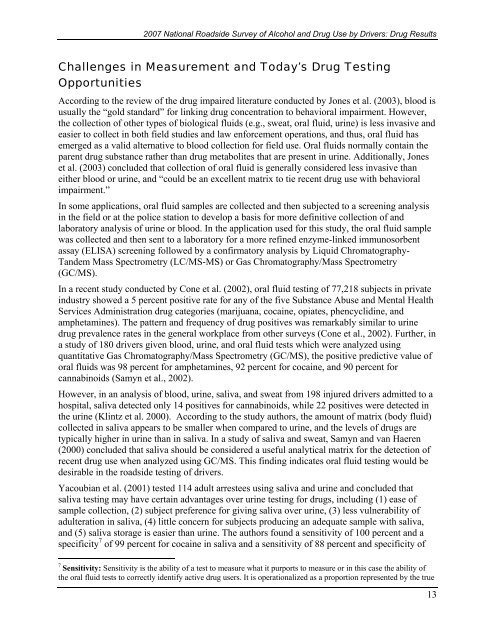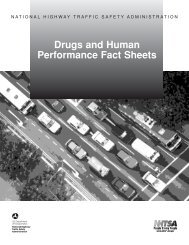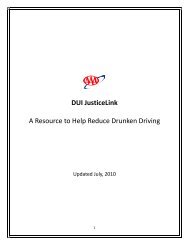2007 National Roadside Survey of Alcohol and Drug Use by Drivers
2007 National Roadside Survey of Alcohol and Drug Use by Drivers
2007 National Roadside Survey of Alcohol and Drug Use by Drivers
Create successful ePaper yourself
Turn your PDF publications into a flip-book with our unique Google optimized e-Paper software.
<strong>2007</strong> <strong>National</strong> <strong>Roadside</strong> <strong>Survey</strong> <strong>of</strong> <strong>Alcohol</strong> <strong>and</strong> <strong>Drug</strong> <strong>Use</strong> <strong>by</strong> <strong>Drivers</strong>: <strong>Drug</strong> ResultsChallenges in Measurement <strong>and</strong> Today’s <strong>Drug</strong> TestingOpportunitiesAccording to the review <strong>of</strong> the drug impaired literature conducted <strong>by</strong> Jones et al. (2003), blood isusually the “gold st<strong>and</strong>ard” for linking drug concentration to behavioral impairment. However,the collection <strong>of</strong> other types <strong>of</strong> biological fluids (e.g., sweat, oral fluid, urine) is less invasive <strong>and</strong>easier to collect in both field studies <strong>and</strong> law enforcement operations, <strong>and</strong> thus, oral fluid hasemerged as a valid alternative to blood collection for field use. Oral fluids normally contain theparent drug substance rather than drug metabolites that are present in urine. Additionally, Joneset al. (2003) concluded that collection <strong>of</strong> oral fluid is generally considered less invasive thaneither blood or urine, <strong>and</strong> “could be an excellent matrix to tie recent drug use with behavioralimpairment.”In some applications, oral fluid samples are collected <strong>and</strong> then subjected to a screening analysisin the field or at the police station to develop a basis for more definitive collection <strong>of</strong> <strong>and</strong>laboratory analysis <strong>of</strong> urine or blood. In the application used for this study, the oral fluid samplewas collected <strong>and</strong> then sent to a laboratory for a more refined enzyme-linked immunosorbentassay (ELISA) screening followed <strong>by</strong> a confirmatory analysis <strong>by</strong> Liquid Chromatography-T<strong>and</strong>em Mass Spectrometry (LC/MS-MS) or Gas Chromatography/Mass Spectrometry(GC/MS).In a recent study conducted <strong>by</strong> Cone et al. (2002), oral fluid testing <strong>of</strong> 77,218 subjects in privateindustry showed a 5 percent positive rate for any <strong>of</strong> the five Substance Abuse <strong>and</strong> Mental HealthServices Administration drug categories (marijuana, cocaine, opiates, phencyclidine, <strong>and</strong>amphetamines). The pattern <strong>and</strong> frequency <strong>of</strong> drug positives was remarkably similar to urinedrug prevalence rates in the general workplace from other surveys (Cone et al., 2002). Further, ina study <strong>of</strong> 180 drivers given blood, urine, <strong>and</strong> oral fluid tests which were analyzed usingquantitative Gas Chromatography/Mass Spectrometry (GC/MS), the positive predictive value <strong>of</strong>oral fluids was 98 percent for amphetamines, 92 percent for cocaine, <strong>and</strong> 90 percent forcannabinoids (Samyn et al., 2002).However, in an analysis <strong>of</strong> blood, urine, saliva, <strong>and</strong> sweat from 198 injured drivers admitted to ahospital, saliva detected only 14 positives for cannabinoids, while 22 positives were detected inthe urine (Klintz et al. 2000). According to the study authors, the amount <strong>of</strong> matrix (body fluid)collected in saliva appears to be smaller when compared to urine, <strong>and</strong> the levels <strong>of</strong> drugs aretypically higher in urine than in saliva. In a study <strong>of</strong> saliva <strong>and</strong> sweat, Samyn <strong>and</strong> van Haeren(2000) concluded that saliva should be considered a useful analytical matrix for the detection <strong>of</strong>recent drug use when analyzed using GC/MS. This finding indicates oral fluid testing would bedesirable in the roadside testing <strong>of</strong> drivers.Yacoubian et al. (2001) tested 114 adult arrestees using saliva <strong>and</strong> urine <strong>and</strong> concluded thatsaliva testing may have certain advantages over urine testing for drugs, including (1) ease <strong>of</strong>sample collection, (2) subject preference for giving saliva over urine, (3) less vulnerability <strong>of</strong>adulteration in saliva, (4) little concern for subjects producing an adequate sample with saliva,<strong>and</strong> (5) saliva storage is easier than urine. The authors found a sensitivity <strong>of</strong> 100 percent <strong>and</strong> aspecificity 7 <strong>of</strong> 99 percent for cocaine in saliva <strong>and</strong> a sensitivity <strong>of</strong> 88 percent <strong>and</strong> specificity <strong>of</strong>7 Sensitivity: Sensitivity is the ability <strong>of</strong> a test to measure what it purports to measure or in this case the ability <strong>of</strong>the oral fluid tests to correctly identify active drug users. It is operationalized as a proportion represented <strong>by</strong> the true13




